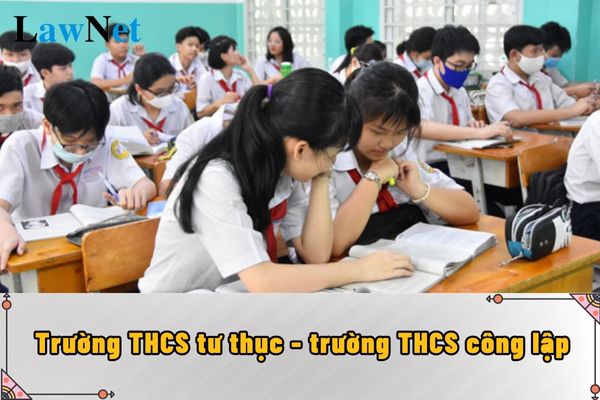Comparison between private lower secondary schools and public lower secondary schools in Vietnam
Comparison between private lower lower secondary schools and public lower lower secondary schools in Vietnam
Based on Article 4 of the Charter of Lower Secondary Schools, Upper Secondary Schools, and Multi-level Schools, promulgated along with Circular 32/2020/TT-BGDDT, regulations on the type and system of lower secondary schools include 2 types: public and private, specifically:
- Public lower secondary schools are established and directly managed by competent state authorities. The investment in infrastructure and the regular operating budget of public lower secondary schools are mainly ensured by the state budget.
- Private lower secondary schools are invested in and guaranteed operational conditions by domestic or foreign investors and are established according to legal regulations. The investment in infrastructure and operating expenses of private lower secondary schools come from non-state budget sources.
Therefore, a comparison table between private lower secondary schools and public lower secondary schools is as follows:
| Criteria | Public Lower Secondary Schools | Private Lower Secondary Schools |
| Objective | Educate students in ethics, intellect, physical health, and aesthetics, nurture talents for the nation. | Can be more diverse, in addition to general education, they can focus on developing special talents and skills for students, meeting the learning needs of specific groups of students. |
| Funding Source | Financed from the state budget. | Self-financed, operates based on tuition fees and other revenue sources. |
| Curriculum | Applies the curriculum prescribed by the Ministry of Education and Training. | May apply the curriculum prescribed by the Ministry of Education and Training or develop its own curriculum suitable to the school's objectives and orientation. |
| Facilities | Facilities are invested from the state budget, which may vary by school. | Generally have more modern and spacious facilities compared to public schools. |
| Tuition | Free or low tuition fees. | Higher tuition fees compared to public schools, varies by school. |
| Class Size | Generally larger class sizes compared to private schools. | Generally smaller class sizes compared to public schools, allowing teachers to pay closer attention to students. |
| Student Benefits | Students enjoy benefits as prescribed by education law. | Students may enjoy additional benefits as prescribed by the school. |
(Based on the Charter of Lower Secondary Schools, Upper Secondary Schools, and Multi-level Schools, promulgated along with Circular 32/2020/TT-BGDDT).
Based on the above comparison, parents can have additional information and choose a suitable type of education for their children according to their needs.

Comparison between private lower secondary schools and public lower secondary schools in Vietnam (Image from the Internet)
Do private lower secondary schools and public lower secondary schools belong to the general education system in Vietnam?
Based on Article 33 Education Law 2019, regulations on general education institutions are as follows:
General Education Institutions
General education institutions include:
1. Primary schools;
2. Secondary schools;
3. Upper Secondary Schools;
4. Schools with multiple levels.
Simultaneously, based on Article 4 of the Charter of Lower Secondary Schools, Upper Secondary Schools, and Multi-level Schools, promulgated along with Circular 32/2020/TT-BGDDT, regulations on the type and system of lower secondary schools include 2 types: public and private.
Therefore, private lower secondary schools and public lower secondary schools are part of the current general education system.
What contents shall be included in the charter of education institutions in Vietnam?
Based on Article 53 Education Law 2019, regulations on the charter and organizational regulations of education institutions in Vietnam are as follows:
Charter and Organizational Regulations of Education Institutions
1. The school's charter applies uniformly to all types of schools in early childhood education, general education, and vocational education and must include the following main contents:
a) Duties and powers of the school;
b) Organization of educational activities within the school;
c) Duties and rights of teachers;
d) Duties and rights of learners;
e) Organization and management of the school;
f) Financial and physical assets of the school;
g) Relationship between the school, family, and society.
2. The organization and operational regulations of education institutions specify the contents of the school's charter to apply to each type of educational institution.
3. The Minister of Education and Training, the Minister of Labor, Invalids and Social Affairs, within their scope of responsibilities and powers, promulgate the school's charter and organizational regulations of education institutions.
Thus, the charter of education institutions must apply uniformly to all types of schools in early childhood education, general education, and vocational education. Therefore, it must ensure the following contents:
{1} Duties and powers of the school;
{2} Organization of educational activities within the school;
{3} Duties and rights of teachers;
{4} Duties and rights of learners;
{5} Organization and management of the school;
{6} Financial and physical assets of the school;
{7} Relationship between the school, family, and society.

